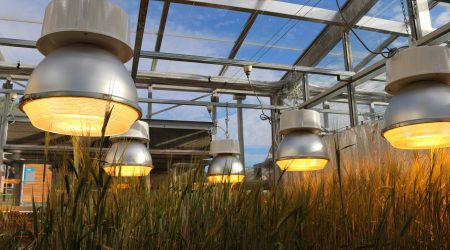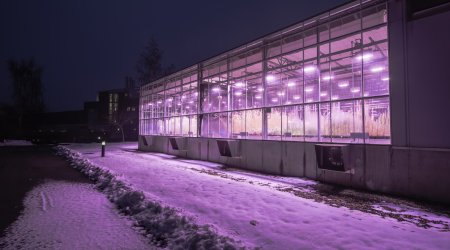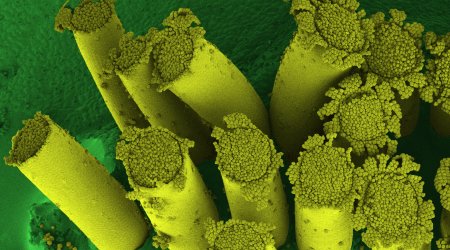A round-up of recent research from the John Innes Centre
Solution to harmful algal blooms raises hope of environmental benefit
A cheap, safe and effective method of dealing with harmful algal blooms is on the verge of being introduced following successful field and lab tests.
Moves to adopt use of hydrogen peroxide (H2O2) as an effective treatment against toxic algae are already underway following the results of new research by a team from the John Innes Centre and the University of East Anglia.
Dr Ben Wagstaff, one of the authors of the study from the John Innes Centre said, “We’ve demonstrated that the use of hydrogen peroxide is a practical, relatively easy way of managing algal blooms.” The work in the Broads National Park could have widespread implications for the way harmful algal blooms are managed in waterways worldwide.
Mistletoe mystery – something’s missing from the kissing plant
Mistletoe has evolved in a manner that makes it unique among multicellular organisms. It is lacking a key piece of machinery essential for aerobic respiration in animals and plants.
An enzyme called Complex I is missing in European mistletoe (Viscum album). Instead, mistletoe uses alternative energy pathways including glycolysis, which generates energy in a different part of the cell. This, combined with the nutrients generously provided by its host trees, provides European mistletoe with all the necessary requirements to keep hale and healthy.
The discovery of mistletoe’s remarkable metabolism provides a unique window into the life cycle of a high-profile parasite in evolutionary time.
Chance discovery links inflammatory bowel disease with common bacterial gut toxin
New research has uncovered a surprise link between a common bacterial toxin found in the gut and inflammatory bowel disease (IBD).
The intercontinental team have established a connection between microcin B17, a well-known toxin produced by E. coli bacteria, and IBD.
The John Innes Centre scientists, led by Professor Tony Maxwell, have been working with microcin B17 for several years in their search for new antibiotics. It is produced by E. coli (Escherichia coli) as a weapon against other bacteria in the gut.
The two teams worked together to show that breakdown products from the toxin seem to trigger gut inflammation that is characteristic of IBD.
The research also identifies the oxazole class of aromatic organic compounds as a new source of environmental and microbial triggers of gastrointestinal inflammation.
Sound new technique tunes into the shifting shapes of biology
It’s one of the major challenges of biology – how to accurately quantify the mass of swarming, shifting shapes that make up the matter of life.
Being able to adequately quantify and compare the shapes of cells or organisms is of ultimate importance for biology. This is because the shape of cells, organs and even entire organisms represent the outcome of internal processes – how genes and proteins interact and trigger biophysical manifestations.
The labs of Dr Veronica Grieneisen and Dr Stan Marée have devised an ingenious method of measuring those elusive life forms thanks to some serious mathematical modelling and a little musical inspiration.
The novel technique, called LOCO-EFA, is already being enthusiastically taken up by international teams of researchers who intend to use it to quantify cell and leaf shape and even palaeontologists investigating the evolution of organism shape.
Periwinkle research uncovers pathway to cancer-fighting drugs
The crucial last steps in a 60-year quest to unravel the complex chemistry of Madagascar periwinkle have been taken, in a breakthrough that opens up the potential for rapid synthesis of cancer-fighting compounds.
After 15 years of research the team have located the final missing genes in the genome of the periwinkle that are devoted to building the chemical vinblastine.
This valuable natural product has been used as an anti-cancer drug since it was discovered in the 1950s. Until now, it has taken approximately 500kg of dried leaves to produce 1g of vinblastine. But the new study uses modern genome sequencing techniques to identify the final missing genes in the pathway.
This research also identifies enzymes that build vinblastine precursor chemicals, which include catharanthine and tabersonine. These can be readily chemically coupled using synthetic biology techniques to give vinblastine.
Temperature resilient crops now an “achievable dream”
The vision of crop improvement in the face of climate change is outlined in research that establishes a genetic link between increased temperature and the problem of ‘pod shatter’ (premature seed dispersal) in oilseed rape.
Research led by Dr Vinod Kumar and Professor Lars Østergaard reveals that pod shatter is enhanced at higher temperatures across diverse species in the Brassicaceae family, including cauliflower, broccoli and kale. This new understanding brings the prospect of creating crops that are better adapted to warmer temperatures a step closer.
Dr Vinod Kumar, a co-author of the paper, explained the findings, saying, “It’s almost as if there is a thermostat that controls seed dispersal, or pod shatter. As we learn how it works, we could in the future ‘rewire’ it so seed dispersal does not happen at the same pace at higher temperatures.”
Controlling seed dispersal, or pod shatter, is a major issue for farmers of oilseed rape worldwide, who lose between 15-20% of yield on average per year due to prematurely dispersed seeds lost in the field.








